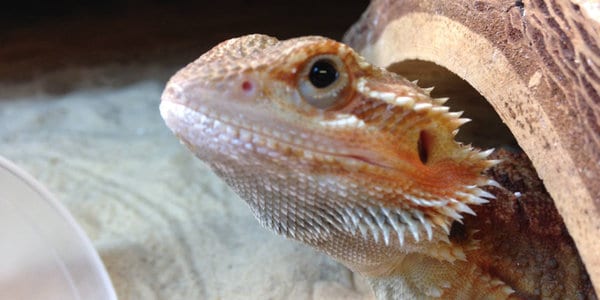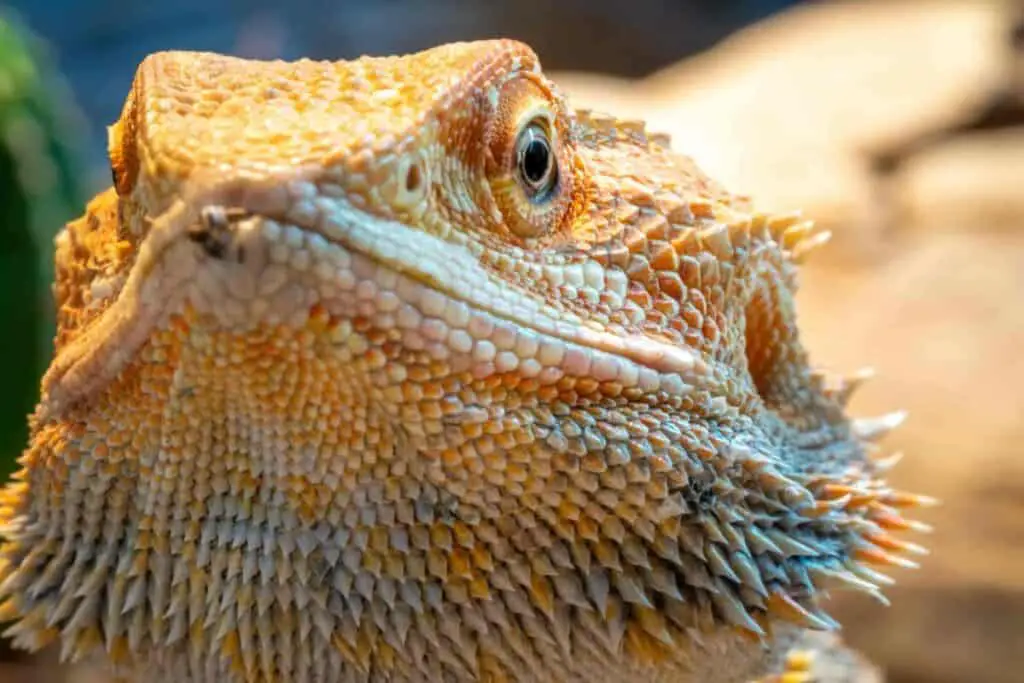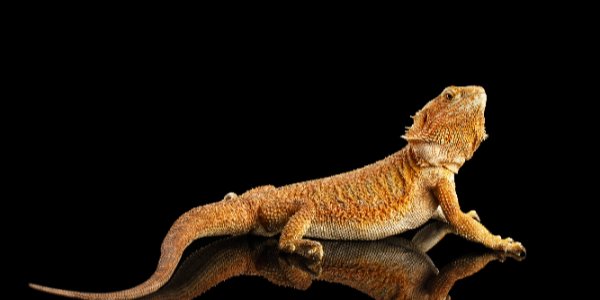Bearded dragons may be friendly, docile, and tolerant to handling, but if you want to have the best moments with these lizards, you need to be acquainted with their unique behaviors. The more you understand about your reptile friend, the greater the chances of providing them with adequate care and healthier and happy life.
There are quite a few behaviors that bearded dragon owners need to familiarize themselves with, from head bobbing and glass surfing to beard puffing and hissing. However, one behavior that tends to confuse many pet owners is bearded dragon crying.
Although several pet owners have reported seeing their beardies tear up, no one understands the real reason for crying. If you have seen your bearded dragon cry and you would like to know why, please keep reading.
Do Bearded Dragons Cry?
You might have seen the expression ‘crocodile tears” used to refer to false or pretense tears. Most reptiles, including bearded dragons and crocodiles, do cry. However, these creatures don’t tear up because of being emotional or getting sentimental, hence the expression.
Reptiles usually cry because their tears help get rid of foreign objects from the eyes. Therefore, if you see your lizard friend crying, it doesn’t mean that they are unhappy. This might be a sign that there is something wrong with their eyes.

What Can Make a Bearded Dragon Cry?
There are multiple reasons why your bearded dragon may be crying. These include:
Dust, Sand, or Other Small Objects
The common cause of crying in bearded dragons is the presence of foreign objects in their eyes. Like human beings experience discomfort and start tearing up when dust or sand gets into their eyes, beardies also have the same experience.
Using a loose substrate in your bearded dragon’s enclosure is discouraged as it is the leading cause of bearded dragons getting small particles and dust in the eyes.
When your bearded dragon has a foreign object in the eye, it might start to cry and even squint. Besides dust, small food pieces can also get stuck in the beardie’s eyes, causing them to tear up.
To ensure that loose particles don’t get into the bearded dragon’s eyes, pet owners should remove loose substrates, such as sand, from the enclosure and replace them with reptile carpets, ceramic tiles, or paper towels.
More importantly, you should help remove the foreign object from the bearded dragon eye by washing it with saline water. You can also use reptile drops as recommended by your local vet.
However, avoid using tap water to clean your bearded dragon’s eyes. Tap water is not 100% sterile and can lead to infections if the eye has a scratch. Instead, alternate between saline eyewash and the reptile drops until the beardie stops crying.
Infection of the Eye
A bearded dragon’s eye could be watering due to illnesses. Although lizards are pretty tough, they are also susceptible to various eye problems that can make them cry. These include conditions such as conjunctivitis and hypervitaminosis A.
Conjunctivitis is the inflammation of the front layer of the eye caused by viruses or bacteria. This ailment causes a pink eye and leads to the eye having multiple red capillaries.
On the other hand, hypervitaminosis A occurs when too much vitamin A is in the body. Since vitamin A is responsible for eye health and overall immunity, too much of it can cause various eye complications like swollen eyes.
Bearded dragon might get their eyes scratched by sharp objects creating a pathway for bacterial and viral infections. Tearing and closing the eyes is often a sign that your bearded dragon suffers from a severe eye problem.
Infection of the eye should not be treated at home. You should visit a reptile vet so that they can recommend medication that will help clear out the infection.
Typically, vets will recommend antibiotics and antibacterial drops to help clear up most eye illnesses, including inflammation and conjunctiva.
If your bearded dragon is crying due to an eye infection, you need veterinary assistance to manage the eye problem effectively.

Wrong Lighting
Poor lighting in the bearded dragon’s cage can cause the bearded dragon to squint and have teary eyes. If the lighting set up in your bearded dragon terrarium is insufficient or too much, it can affect the bearded dragon’s eyes, making them watery.
Bearded dragons require a powerful source of UVB and UVA light. Tube lamps are the best since they evenly distribute light across the tank.
More importantly, the lamps should be positioned safely from the reptile. However, only tanks measuring over 25 gallons should have tub lights.
Ensure that you don’t use full-spectrum lights or coiled bulbs meant for people and plants in a bearded dragon terrarium.
They’re too strong and may affect the eyes, making them teary. Avoid using subpar UV lights for your bearded dragon enclosure, as they can damage your bearded dragon’s eyes when used for an extended time.
If you suspect that there’s too much light in the enclosure, switch off the lamps for 2-4 days and see whether your beardie will stop crying. If it does, you should invest in new quality UV lights. Bearded dragons need powerful lamps (UVB 10.0 – 12.0)
Stuck Shed
Although shedding is meant to be flawless, sometimes it can be disastrous due to unfavorable conditions such as low humidity. Some sheds can get stuck around the eye when your bearded dragon is shedding.
Bearded dragons will try to remove this skin by rubbing themselves against various surfaces. These creatures might rub themselves against sharp and hard objects and, in the process, scratch or injure their eyes. Beardies may cry because of the irritation from the stuck shed or the injuries sustained when trying to remove the skin.
This is why bearded dragon owners need to help their lizards through the shedding process. They can remove the stuck skin in the eye region using soft cotton dipped in warm water. Giving your reptile friend a warm bath can also help get rid of the shed and reduce eye irritation.
Additionally, you should also ensure that humidity levels in the enclosure are optimal. You should maintain humidity around 20 to 40%.

Parasites
Parasites can also cause tearing and swelling of the bearded dragon’s eyes. Some parasites, such as termites, usually infest the area around the eye, creating inflammation and shedding problems.
Mites manifest as red or black dots around the eyelids. Other parasites that might attack your beardies are ticks. Although they are usually found in wild reptiles, ticks also attack captive-bred lizards when they contact other animals. Ticks invade the area near the eye, causing irritation, swelling, and even infections.
If you spot parasites on your bearded dragon, you need to clean and treat its enclosure. If the parasites have already caused infections or inflamed the eye, you need to visit a reptile vet.
How Long Will It Take Before Bearded Dragons Stop Crying?
The tearing will cease immediately if the foreign object is cleaned out of the bearded dragon’s eyes. For owners who stay for a long time without noticing the teary eyes in beardies, it may take between 1-4 weeks before the crying stops completely.
Eye scratches or infections can take time to heal. The period for the eyes to recover from illnesses and lacerations will depend on how quickly the problem was discovered and treated.
If you visit your vet once you notice your bearded dragon having watery eyes, it will take one or two months for the infection to heal completely.
How to Prevent Bearded Dragons from Crying
- Select substrates that don’t have loose particles. Opt for substrates such as shelf liners, reptile carpets, paper towels, and tiles, which don’t have tiny particles that might get into the bearded dragon’s eyes.
- Keep the enclosure clean and healthy. Daily, weekly, and monthly cleaning routines will reduce the risks of mites and other parasites that attack the bearded dragon’s eyes and cause them to tear.
- Provide optimal conditions in the bearded dragon’s tank. Ensure that the humidity is right within the terrarium for successful shedding. Conversely, provide adequate light and temperature to ensure that your lizards get enough UVA and UVB rays for optimal growth and development.
- Get rid of sharp objects from your bearded dragon enclosure. Remove all accessories and furniture that might poke or scratch your bearded dragon’s eye.
- Provide a healthy diet. Give your beardies the proper diet laced with calcium and vitamin supplements to curb deficiencies that might lead to shedding.
Final Verdict
If you ever catch your bearded dragon crying, don’t ever think that this is something to do with their emotional well-being. There are a few aspects that might cause your lizard to cry.
They might have dust or sand particles in their eyes or parasites. Also, their eyes may be infected, or they might be responding to poor lighting. They also might have shed stuck around the eyes.
Bearded dragon owners can help get dust and sand particles out of their lizard’s eyes by washing them with a soft cloth and saline solution.
However, you need to visit a reptile vet for infections and issues caused by poor lighting and diet. The professionals will do a blood test or culture swab and recommend the best medication.